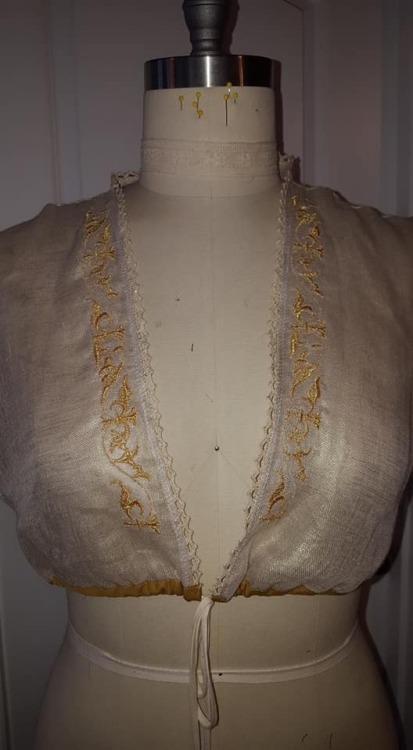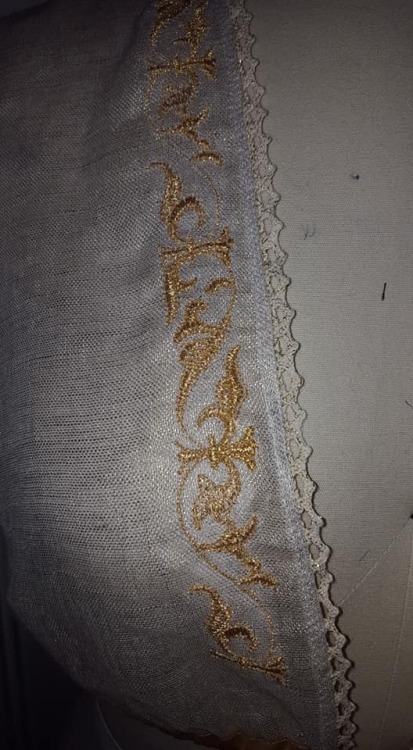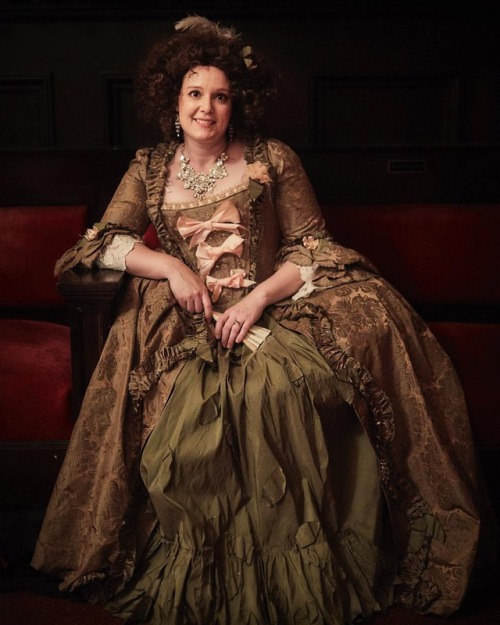#periodcostume
Finished natural form bustle ✂️ I love the serendipitous show through of my dress back #bustle #sewing #stripes #wip #cosplay #historicalcostume #costume #westworld #pattern #periodcostume #periodcostumeforstageandscreen #futurecosplay #westworld #victorian #gothic #goth #corset #authenticcorset #corsetry
Post link
Another UFO ✂️ I made a cage bustle several years ago; cut out, but never finished this matching natural form companion for the slimmer 1880’s styles. I have been dreaming of making a Westworld Cosplay so I might use this and the matching corset underneath. Pattern is from Period Costumes for Stage and Screen. #bustle #sewing #stripes #wip #cosplay #historicalcostume #costume #westworld #pattern #periodcostume #periodcostumeforstageandscreen #futurecosplay #westworld #victorian
Post link
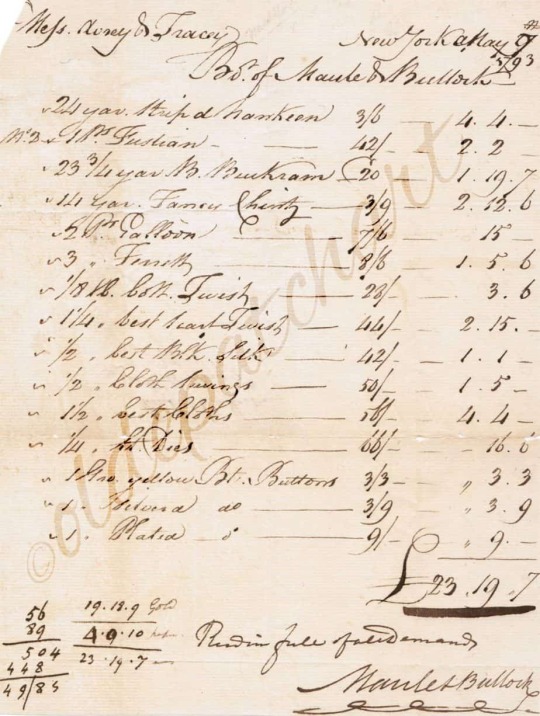
In this century, when we think of “calico” we more than likely envision a cotton with a small print a la Little House on the Prairie, but calico in the 18th century was just a name for printed cottons and had nothing to do with a specific pattern or design.
It’s interesting to note just “how” printed fabrics were accomplished. A wood carver would create a wooden block of a pattern - such as a cluster of flowers, etc. That block or “stamp” would then be brushed with mordant to make the dye adhere to the fabric. The artisan would then stamp the design on the fabric, then dye the whole piece. It would then be rinsed to reveal the stamped design.
Attached is a copy of a bill of goods from New York dated 1793. I needed to know how much a yard of printed cotton would cost for one of my novels that is set in 1773. As a writer, research of such minutiae is par for the course, but as a costumer I was doubly curious.
“Chintz” was a type of printed cotton produced in India, The Calico Acts (1700, 1721) banned the import of most cotton textiles into England, followed by the restriction of sale of most cotton textiles. It was a form of economic protectionism, largely in response to India (particularly Bengal), which dominated world cotton textile markets at the time. Parliament began to see a decline in domestic textile sales, and an increase in imported textiles from places like China and India. Seeing the East India Company and their textile importation as a threat to domestic textile businesses, Parliament passed the Calico Acts as an attack on textile importation. This is the same reasoning Elizabeth-1 enacted sumptuary statutes on “black dyed woolen hats.” But I leave that topic for another time! The point being is that protecting English trade by banning certain imports was not a new device.
During the 18th century the monetary system in the colonies was in pounds shilling and pence. There were 20 Shillings to the pound and 12 Pence per Shilling. Also at the same time each colony had their own currency system. For instance the New York pound was worth 30% less than British sterling, with a NY shilling equivalent to only 8 pence sterling instead of the usual 12. Among the list of goods purchased on the 7th of May 1793 according to the bill of sale pictured, is a 14 x yards length of ‘Fancy Chintz’. It cost 3 shillings 9 pence per yard with the total cost coming to two pounds, twelve shillings and 6 pence.
Now, do not quote me as an expert. I’ve drawn my information from several on-line sources and it’s been suggested that these prices are very likely listed at wholesale, or purchased for “cost,” as the buyers themselves were merchants and would mark it up to make a profit.
Let’s consider wages in the time period of 1773 thereabouts. According to what I’ve been able to source on-line, the average wage for a farmer would be about 10 pounds per year. A day laborer, or farm hand, would make about 6 shillings per month. When you work out the comparison using wages of each era and try to calculate how much ONE yard of chintz would cost, it appears that it was equivalent to approximately three quarters of a day’s wage (in 1793).
Depending on the width of the fabric a typical round gown, which is a gown that isn’t split up the front and worn with a decorative petticoat, would take about 6 yards or more. I’m making that estimate based on what “I” would purchase for a textile that is 45" wide. That means the cost of ONE gown would equal to about a week’s wages! HOLY COW!
For us in 2021, cotton is an inexpensive textile. A polished cotton or chintz now days costs about $20 a yard. The brown and ivory fabric I used in the recent gown I shared cost about $19 a yard because it was a historical reproduction, but on average printed cottons cost about $10 a yard, while wool fetches a price of anywhere from $25 to $40 a yard! In the 18th century wool would have been much more affordable than cotton chintz or calico.
I’ve included some of my FAVORITE cotton prints that I’m anxious to have an opportunity to use on a robe a’ la polonaise! They are ALL available on Spoonflower. They are NOT historical reproductions, but… close enough to pass some prints from the 18th Century.



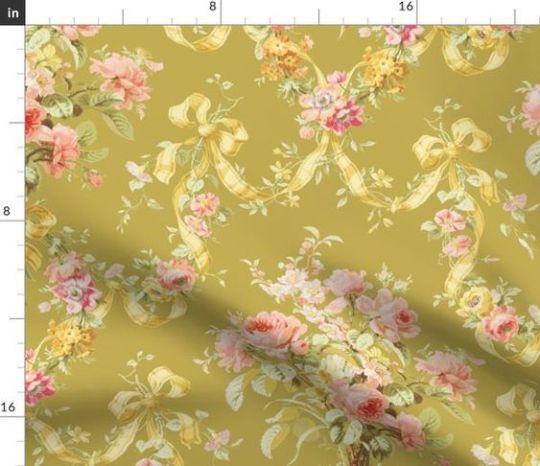
You can view my full “collection” of cotton prints on my Pinterest page:https://www.pinterest.com/…/cotton-prints-historical…/
A blog I used for reference: https://oldepatchart.com.au/…/11/18/yard-chintz-cost-1793/
Other sources were found on a Google search.
16th Century Italian Underpartlet. This gauze weight metallic linen comes at a precious price at $28 a yard, but it’s so pretty!!
Post link
Prince Albert #thegreatdickenschristmasfair #portrait #periodcostume #gigphotographer #philippavliger2k20
https://www.instagram.com/p/BrGi6gOAVi9ZXy79Frv4CIhQXZg2-9oiB6yL1I0/?utm_source=ig_tumblr_share&igshid=15pe01ewqidw6
Post link
Le Bal des Vampires. #vampire #costume #periodcostume #painting #photography #gigphotographer #philippavliger2k20
https://www.instagram.com/p/BpxJz61AjGu8x2f5yYc2N3QMbkQ_EZx74ppzEE0/?utm_source=ig_tumblr_share&igshid=318hu0fhajeg
Post link
Will be walking with the undead later. Hope to see you Sunday. #PEERS #vampire #undead #vampires #dance #periodcostume #gigphotographer #philippavliger2k20
https://www.instagram.com/p/Bpuc2ingjpVpc73EuykpGb4ww62huOCPRQubeg0/?utm_source=ig_tumblr_share&igshid=48948x32q510
Post link



